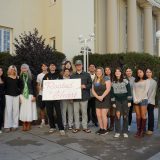The Art of Writing about Art Part 4: Ann Hamilton in Metaphor
November 12, 2015
With Ann Hamilton’s Warp & Weft II, mundane materials (paper, ink) and mundane subject matter (a textile, drawn thin) expand in the imagination to the level of the sublime. Philip Pedersen (Senior, Screen Acting/English) and Jacob Walker (Senior, Screenwriting/Television) were drawn in by the painterly lithograph’s subtle pull, and attempted to find adequate metaphors to describe the scope of Warp & Weft II: cancer cells, explosions, smoke, hair, cauliflower, bubbles, glaciers, and eruptions. Hamilton’s lithograph becomes in these readings a world unto itself.
Philip Pedersen
As suggested by the title, this striking piece of distressed textile explores the warp and weft, crosswise structure of woven cloth. The abstract clusters, which almost look like cancer cells under a microscope, or perhaps tiny, controlled explosions, connote a feeling of contained chaos. There is no discernible focal point, and the objects are arranged in such a way as to achieve a composition that is stable, yet full of movement. Light and shadow create the illusion of three-dimensionality while the flowing, curvilinear forms are full of energy – particularly in the places where they converge. They almost appear to be swelling or surging, and in some places coiling like rising smoke. This suggestion of movement, which extends beyond the boundaries of the frame, contrasts comfortably against a muted background.
The color renders Hamilton’s work sober, nearly clinical. This vast, grey, negative space has the effect of diffusing the chaos, and greyness on its own is reserved, quiet; it has a steadying effect to compliment the gritty clumps. Up close their texture appears coarse, almost hairy, but take a step back and more geometric (octagonal and diamond) structures start to reveal themselves. These convincingly volumetric cauliflower-like shapes, from afar, look like steep buttes in an aerial perspective of a barren landscape, and convey tones of isolation. Furthermore, this image of nature speaks to the overall organic appearance of the piece: lines anarchically distorted and woven like veins in a leaf, florets in broccoli, or the crosshatched rifts in tree bark. Thus from the dead, flat surface of fabric there emerges a sense of life.
Jacob Walker
Warp & Weft II depicts jagged, bubble-shaped distortions pushing into the foreground from a greyish blue fabric-like background that appears to be billowing outwards towards the viewer. This juxtaposition of expectations, with harsh, geologic distortions appearing from a seamless, man-made background creates a sense of mysteriousness and oddity, since what the viewer recognizes as a seemingly natural phenomenon is occurring from an unnatural and fabricated source.
Warp & Weft II further toys with the viewer’s perception of supposed movement. The eye is naturally drawn towards the various distortions since they are the piece’s most recognizably three-dimensional elements and their heavy lines and slight, realistic shadows, create rougher, more prominent textures. But these puckered nodes are actually the work’s most static points. Ironically, the true movement of the piece comes from the much subtler background. While the heavy, craggy distortions hint at a long passage of time, in a glacial or topographical sense, the seemingly plain background is full of a present, undulating movement. This inversion of the viewer’s expectation for where solidity and movement should occur in a “landscape” reveals the artist’s attempted concealment of Warp & Weft II’s truly alien qualities, lulling the viewer into a false sense of logical security.
Warp & Weft II’s unbalanced composition further contributes to its masquerading realism. The distortions appear to be randomly bunched and seem to occur more frequently just above the horizontal axis and towards its center for no apparent reason. This intentional lack of symmetry and deliberate cloaking of man-made intention in the placement of these distortions lends validity to the illusion that they truly are primordial formations that have erupted due to overwhelming pressure from underneath the woven scenery.
The piece’s frame contributes to this conceit as well. The distortions that appear along the edges of the frame are cut off. This implies that these forms and the artificial landscape they sprang from continue out of sight in every direction. This technique is reminiscent of landscape painting or nature photography, but is instead utilized to trick the eye into believing that these impossible forms could not only appear from the fabricated background, but that this is just a snippet of their true presence.
Warp & Weft II incites the viewer to question their perceived natural order of things, while simultaneously trying just as hard to deceive the viewer into believing that this unfeasible mixture of elements is realistic. Thus, Warp & Weft II radically revises the logic behind the basic rules of nature and their relationship to man’s own creation, but does so in a subtle almost unconscious way in order to more gently convey that humanity’s notion of “what is and what isn’t” is overly rigid and that the natural world and the “civilized” world are not so far apart.



